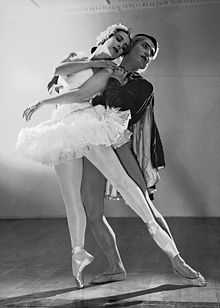Opéra-ballet
Opéra-ballet was a popular genre of French Baroque opera, "that grew out of the ballets à entrées of the early seventeenth century."[1] It differed from the more elevated tragédie en musique as practised by Jean-Baptiste Lully in several ways. It contained more dance music than the tragédie and the plots were not necessarily derived from Classical mythology and allowed for the comic elements which Lully had excluded from the tragédie en musique after Thésée (1675). The opéra-ballet consisted of a prologue followed by a number of self-contained acts (also known as entrées), often loosely grouped round a single theme. The individual acts could also be performed independently, in which case they were known as actes de ballet.
The first work in the genre is generally held to be André Campra's L'Europe galante ("Europe in Love") of 1697,[2] but Les Saisons[3] of 1695 is so typical of the genre that it is mentioned as the most distinctive prototype of this sort of composition,[1] although the latter has a mythological plot. Famous later examples are Les élémens (1721) by Destouches, Les Indes galantes (1735) and Les fêtes d'Hébé (1739) by Jean-Philippe Rameau.
Notes
- ↑ 1.0 1.1 Pitou, art. "Opéra-ballet", p. 278
- ↑ Warrack, John and West, Ewan (1992), The Oxford Dictionary of Opera, 782 pages, ISBN 0-19-869164-5
- ↑ composed by Pascal Collasse and by Louis Lully, possibly by also borrowing from the late (that is, Jean-Baptiste) Lully (Pitou, art. "Les Saisons", pp. 308-9)
References
- Pitou, Spire, The Paris Opéra. An Encyclopedia of Operas, Ballets, Composers, and Performers – Genesis and Glory, 1715-1815, Greenwood Press, Westport/London, 1983 (ISBN 0-313-21420-4)
- Warrack, John and West, Ewan (1992), The Oxford Dictionary of Opera, 782 pages, ISBN 0-19-869164-5
|
|---|
| | General information | | |
|---|
| | Ballet terminology | |
|---|
| | Ballet by genre | |
|---|
| | Ballet by region | |
|---|
| | Dancers |
- American
- British
- French
- Russian
|
|---|
| | Technique | |
|---|
| | Ballet apparel | |
|---|
| | Ballet portal |
- Did you know?
- Recent news
- Today's article
- Today's biography
- Today's news
- Today's picture
|
|---|
|
